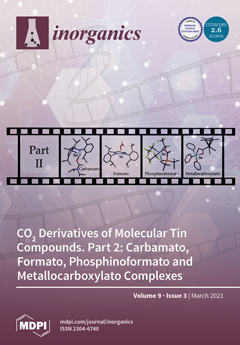Single-crystal X-ray diffraction structures of organotin compounds bearing hemicarbonate and carbonate ligands were recently reviewed by us—“CO
2 Derivatives of Molecular Tin Compounds. Part 1: Hemicarbonato and Carbonato Complexes”,
Inorganics 2020,
8, 31—based on crystallographic data available from the Cambridge Structural
[...] Read more.
Single-crystal X-ray diffraction structures of organotin compounds bearing hemicarbonate and carbonate ligands were recently reviewed by us—“CO
2 Derivatives of Molecular Tin Compounds. Part 1: Hemicarbonato and Carbonato Complexes”,
Inorganics 2020,
8, 31—based on crystallographic data available from the Cambridge Structural Database. Interestingly, this first collection revealed that most of the compounds listed were isolated in the context of studies devoted to the reactivity of tin precursors towards carbon dioxide, at atmospheric pressure or under pressure, thus highlighting the suitable disposition of Sn to fix CO
2. In the frame of a second part, the present review carries on to explore CO
2 derivatives of molecular tin compounds by describing successively the complexes with carbamato, formato, and phosphinoformato ligands, and obtained from insertion reactions of carbon dioxide into Sn–X bonds (X = N, H, P, respectively). The last chapter is devoted to X-ray structures of transition metal/tin CO
2 complexes exhibiting metallocarboxylato ligands. As in Part 1, for each tin compound reported and when described in the original study, the structural descriptions are supplemented by synthetic conditions and spectroscopic data.
Full article





